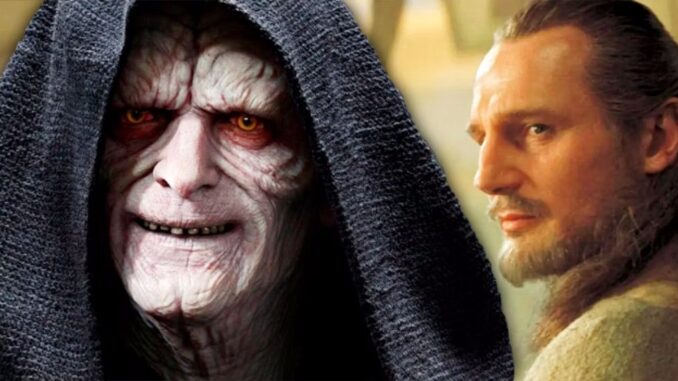
Why Palpatine Feared Qui-Gon Jinn More than Master Yoda in Star Wars
Much of the dialogue in the Star Wars prequels was incredibly awkward, from Obi-Wan’s “I have the high ground” to Anakin’s “I don’t like sand.” Yet, it got the point across. Perhaps the best example of bad dialogue with a deep message arrives in The Phantom Menace, when Yoda cautions, “Fear leads to anger. Anger leads to hate. Hate leads to suffering.” That perfectly foreshadowed not only Anakin’s fall to the dark side but also, if more quietly, the rest of The Phantom Menace: Palpatine was in the earliest stages of his plan to take over the galaxy, and he was afraid a certain Jedi might get in his way. Interestingly, however, that Jedi wasn’t Yoda or Master Windu, but instead Qui-Gon Jinn.

Qui-Gon is one of the most powerful Jedi in the saga: highly skilled in the Force and mastering abilities that other Jedi couldn’t, including the ability to consciously manifest after death. But more than his abilities as an individual, it was his maverick philosophy that the Emperor feared. In order for Palpatine to pull off his coup, he needed to decapitate the entire Jedi Order in a single blow. Qui-Gon could have potentially disrupted that simply by refusing to go along with the Order’s wishes. It’s the same trait he used to find Anakin in the first place, and indeed: had he lived, he might very well have prevented Anakin’s fall to the Dark Side. While Palpatine could box in the likes of Yoda and Mace Windu, despite their ability to match him with a lightsaber, Quin-Gon represented a threat of an entirely different sort.
Updated, December 22, 2023 by Robert Vaux: The article has been updated to include additional information about Qui-Gon Jinn’s unorthodox approach to the Force, and the ways in which it makes him an active detriment to Palpatine’s plans. It also cites specific examples of how the Jedi’s hidebound orthodoxy drove potential allies into the enemy’s hands, and how Qui-Gon could have altered that equation had he lived.
How Palpatine Engineered the Jedi Order’s Destruction
Naturally, Palpatine wanted to rule the galaxy, but he was driven by a desire to see the Jedi Order obliterated. His primary objective was to pull the wool over the Jedi’s eyes until the time was right. He juggled his chancellor persona with his covert activities as Darth Sidious. Blinded by hubris, the Jedi made Palpatine’s job easier: aided by the manufactured crisis of the Clone Wars and the calcification of an Order that valued protocol over purpose. Not even Yoda, Grand Master of the Jedi Order, proved an obstacle to Sidious’ plan. Like most of the Jedi in the prequel trilogy, Yoda was so preoccupied with the Clone Wars that he lost sight of serving the Force. By the time the threat Palpatine posed was detected, it was too late to act.
That’s one reason why Yoda chose to go into exile after failing to defeat Palpatine in a duel. He understood he lost the ethereal battle before their physical fight even began. Thus, Palpatine never viewed Yoda as a major concern, even though the Jedi Master fought him to a de facto draw during the events of Revenge of the Sith. Mace Windu was similarly caught off-guard by Palpatine’s treachery, and unlike Yoda, he had the Sith Lord beaten cold in their battle. Anakin Skywalker’s fall to the Dark Side provided Sidious with an ace in the hole, and while Windu came closer than anyone to stopping Palpatine’s ascent, he too couldn’t perceive the threat until it was too late.
Anakin himself is an object lesson of the Jedi’s failure, and the totality of Palpatine’s ruse. The Order was uncomfortable with Anakin’s growing power and took steps to keep him off the Council, leading him straight into the Sith’s hands. Count Dooku fell to Sidious the same way, and for the same reasons, which allowed Palpatine to successfully engineer the break-up of the Republic. The Jedi drove these figures away with their hubris and inflexibility, and both of them ultimately became Palpatine’s catspaws as a result. A similar — though more oblique — figure is Sifo-Dyas, the Jedi who commissioned the creation of the Clone army from the Kaminoans.
As revealed in Star Wars: The Clone Wars Season 6, Episode 10, “The Lost One,” he believed that the Republic would soon face an existential crisis after the events of The Phantom Menace. He was removed from the Council, who believed his ideas were too extreme. He went ahead anyway — commissioning the creation of the Clones while falsely claiming to be acting in the name of the Galactic Senate — and refrained from telling the Jedi Council. Palpatine and Dooku became aware of his actions in some unknown fashion and interceded to turn the situation to their advantage. As with Anakin and Dooku, the Jedi created big problems for themselves because they lack flexibility of thought and refused to see the rising tide of danger.
Why Qui-Gon Jinn Was Palpatine’s Greatest Threat
Unlike Yoda and the Jedi High Council, Qui-Gon Jinn was only concerned about the will of the Force. He was less concerned about politics and orthodoxy, and happily paid the price for doing so: even rejecting a spot on the Council in favor of following the Force in his own manner. And unlike his former master Count Dooku, he wasn’t susceptible to the siren call of the Dark Side. His connection to the Light Side was too strong, and indeed, his willingness to follow it over the dictates of the Council made him far more dangerous to Palpatine’s plans. With it, he could have detected the Sith lord’s plans far earlier than the Council did, and his past with Dooku would have made it easy for him to spot the Separatist’s schemes. Most importantly, his pledge to train Anakin in the ways of the Force would have doubtless been more successful than the well-meaning but inexperienced Obi-Wan. Not only would that have kept Anakin from succumbing to the Dark Side, but he might have prevented the Galactic Civil War in the first place, as well as flushing out the Sith Lord before Palpatine was ready.
Therefore, Palpatine needed Qui-Gonn out of the way because he was better connected to the Force than the other Jedi. If Qui-Gon had survived the events of The Phantom Menace, he would have sensed Palpatine’s evil, and Anakin wouldn’t have become Darth Vader. Everything hinged on removing him early — almost as soon as Palpatine became aware of his presence — and indeed, once Quin-Gon was out of the way, he moved very quickly to insinuate himself with Anakin: taking advantage of his foe’s death while the other Jedi were still mourning him. Thus, while Qui-Gon was less powerful than the likes of Yoda and Mace Windu, Palpatine feared him more. In simplest terms, he was a wild card, and with the Sidious executing an intricate decades-long plan to seize power and destroy the Jedi, a wild card was something he just couldn’t afford.
That’s also why The Phantom Menace was such an important Star Wars film. When Qui-Gon Jinn showed up on Naboo and threatened to throw a bantha-sized wrench into his plot, Palpatine had to act fast. He dispatched Darth Maul to get rid of the Jedi Master once and for all. Maul was an unknown at the time, and lacked both Dooku’s ambition and Palpatine’s capacity for plotting. He was simply an assassin, there to kill whom his master told him to and otherwise unconnected to his larger schemes. (And as Palpatine revealed again and again, his apprentices were all disposable.) Qui-Gon’s arrival on Naboo would have alerted the future Emperor to his presence and allowed him to dispatch Maul. He admonished his apprentice to “move against the Jedi first” before returning Padme to Naboo, allowing him to strike down Qui-Gon early enough to keep the maverick Jedi from spoiling his plans further. Therefore, just like Yoda said, Palpatine’s fear led to evil deeds, death and the rise of the dark side. That all began with Qui-Gon’s death, as Palpatine removed his biggest obstacle first and allowed his grand scheme to move forward.
